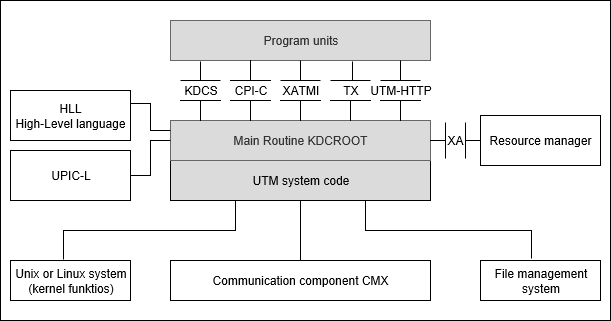To achieve the greatest possible level of portability, the UTM system code only uses the system calls and library functions provided by Unix and Linux systems within the framework of the X/Open universe (system V):
functions for requesting and releasing internal system storage areas (local process storage area and shared memories)
functions for serialization (semaphores)
functions for creating and terminating processes
functions for timing resources and time-driven messages
functions for editing files and databases
In addition to the interfaces to the operating system, a UTM application has a range of other internal interfaces:
XA interface (X/Open standard) for connecting external resource managers(such as Oracle, INFORMIX)
UPIC-L interface which enables UTM client programs to be connected locally to the UPIC carrier system (i.e. the client programs can run in the same Unix or Linux system as the UTM application)
interfaces to the runtime systems of the programming languages used
interfaces to the communication components PCMX
The program units access the functions via the program interfaces of openUTM, i.e. via theX/Open interfaces CPI-C and XATMI + TX or via the KDCS interface (German standard).
Figure 43: openUTM interfaces to other system components
openUTM is executable on 32-bit and 64-bit platforms, but a mixed operation of 32-bit and 64-bit is not possible within a UTM application.
When the application is started and a utility is started, the system checks whether the components used are compatible with each other with regard to the platform and the bit mode.

